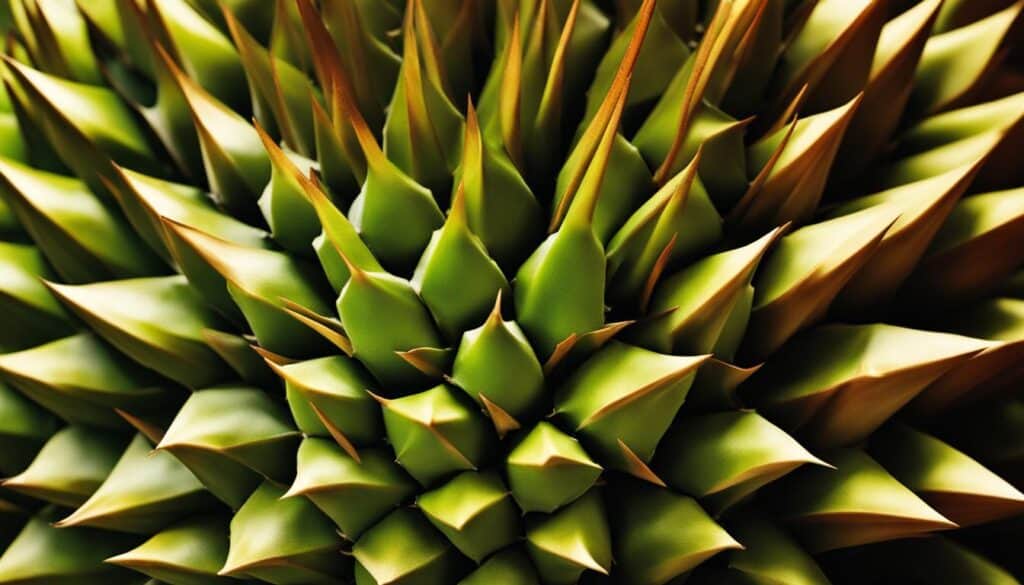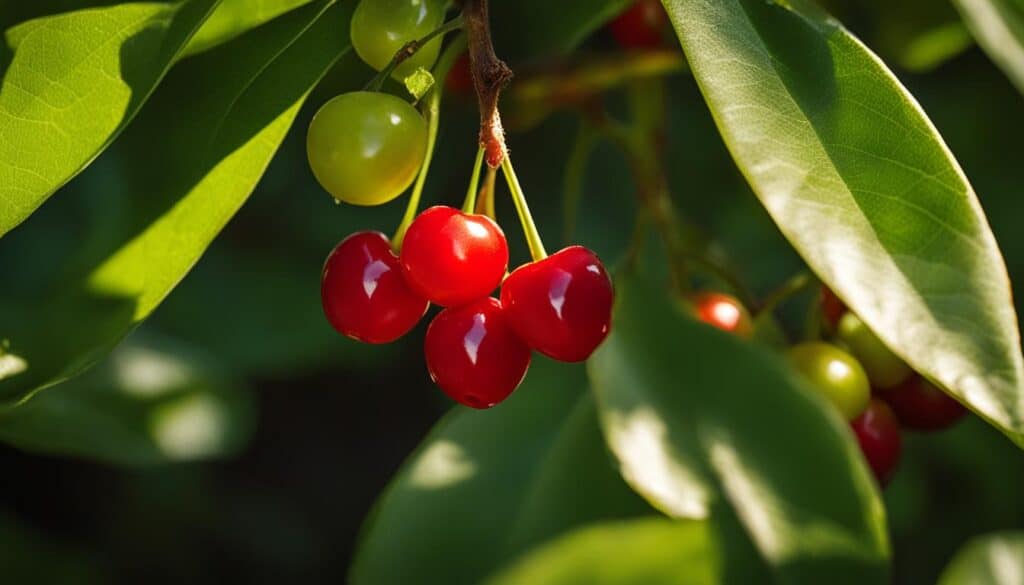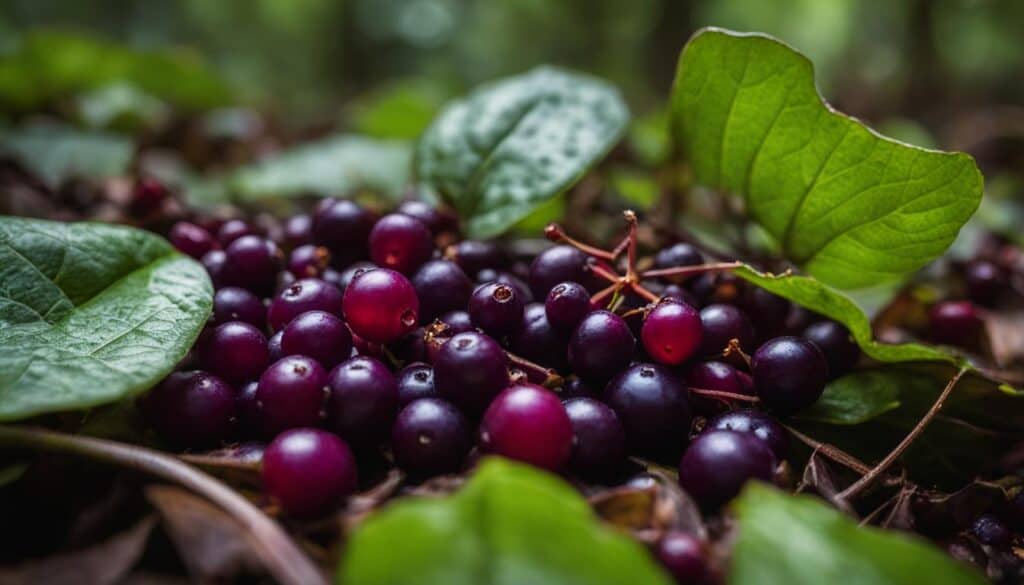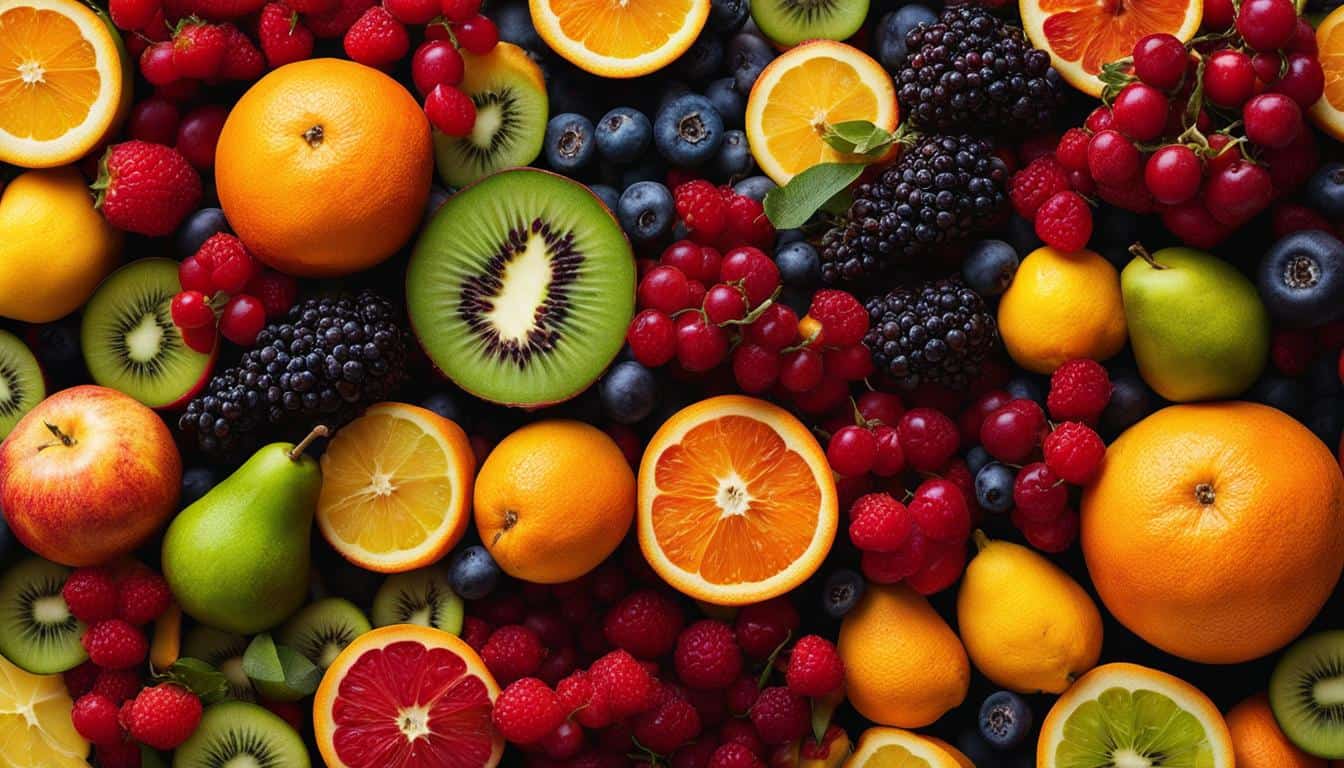Are you ready to embark on a mouthwatering adventure to discover the best fruit in the world? Join us as we explore the flavor and health benefits of 18 rare and exotic fruits from around the globe. From the schisandra berries of Northern China to the durian, the “King of Fruits” in Southeast Asia, we’ll take you on a journey to tantalize your taste buds and nourish your body.
Key Takeaways:
- Discover the flavor and health benefits of 18 rare and exotic fruits
- Explore fruits from different regions around the globe
- Tantalize your taste buds with unique and delicious flavors
- Nourish your body with essential nutrients found in these fruits
- Expand your culinary repertoire with these exotic fruits
Schisandra Berries: A Flavorful and Health-Boosting Fruit
When it comes to unique flavors and impressive health benefits, few fruits can compare to schisandra berries. Also known as “five-flavor berries” or omija fruits, these small, red berries originate from Northern China and Russia. What sets them apart from other fruits is their ability to tantalize all five taste buds, offering a combination of sweetness, sourness, bitterness, saltiness, and umami.
But schisandra berries offer more than just a flavor experience. These berries are loaded with antioxidants, making them a powerhouse for promoting overall health and well-being. In fact, they have been used in traditional Chinese medicine for centuries to boost vitality and strengthen the immune system.
Schisandra berries are not only delicious but also packed with antioxidants, making them a valuable addition to any diet.
Whether you enjoy schisandra berries fresh, dried, or in the form of tea or supplements, incorporating them into your daily routine can provide a flavorful and health-boosting addition to your diet. From supporting immune function to protecting against oxidative stress, schisandra berries are a fruit worth exploring for their unique taste and wellness benefits.
References:
- “Schisandra Berry”. American Botanical Council. Retrieved from https://abc.herbalgram.org/ingredient/schisandra-berry/
- “Schisandra”. WebMD. Retrieved from https://www.webmd.com/vitamins/ai/ingredientmono-376/schisandra
Durian: The King of Fruits with a Notorious Smell
The durian, a fruit native to Southeast Asia, is often hailed as the “King of Fruits” due to its large size and unique characteristics. While its flavor is a delightful combination of sweetness, creaminess, and savory notes, its smell is notoriously pungent and has been compared to a mix of rotten eggs, rotten cabbage, skunk, and fruit. This odor has earned durian the distinction of being banned in public places and hotels in some countries.
Despite its infamous smell, durian is highly valued for its nutritional content. This exotic fruit is an excellent source of dietary fiber, B-vitamins, and vitamin C, making it a healthy addition to your diet. It also contains healthy fats that provide essential nutrients and support overall well-being. Durian is a versatile fruit that can be enjoyed fresh or used in a variety of dishes, including desserts, ice creams, and smoothies.
“Durian: the smell is something you’ll either love or hate, but the taste is undeniably exquisite.” – Local food blogger

While the durian may not be for everyone due to its strong aroma, it is undoubtedly a unique and fascinating fruit that captivates the senses. Its creamy texture, complex flavor, and abundant nutrients make it a must-try for adventurous eaters and fruit enthusiasts alike.
| Nutritional Content | Per 100g |
|---|---|
| Dietary Fiber | 9.2g |
| B-vitamins | varies |
| Vitamin C | 33mg |
| Healthy Fats | 13g |
Rambutan: A Hairy Fruit with Sweet and Juicy Flesh
Get ready to explore the fascinating world of rambutan, a unique and exotic fruit found primarily in Malaysia and Indonesia. Its name, which means “hairy” in Malay, perfectly describes the fruit’s appearance. With its spiky red exterior, the rambutan is sure to catch your attention.
But don’t let its exterior fool you, because beneath the hairy rind lies a delicious treasure. The fruit inside resembles a mix of lychee and grapes, with a sweet and juicy flesh that will leave you craving for more. It’s no wonder that rambutan is often referred to as nature’s candy.
The Benefits of Rambutan
Aside from its delightful taste and texture, rambutan also packs a nutritional punch. It is a rich source of vitamin C and antioxidants, which can help boost your immune system and protect your body against free radicals. Additionally, rambutan seeds have been used in traditional medicine to treat various ailments, including inflammation, bacterial diseases, diabetes, and even cancer.
| Nutritional Information | |
|---|---|
| Vitamin C | 25mg |
| Antioxidants | High |
| Medicinal Uses | Inflammation, bacterial diseases, diabetes, cancer |
So, the next time you come across rambutan in your local grocery store or on your travels, be sure to give this delightful fruit a try. Its unique appearance, sweet and juicy flesh, and health-boosting properties make it a must-have addition to your fruit basket.
Cornelian Cherry: An Exotic Fruit with Health-Boosting Benefits
The lesser-known cornelian cherry is a unique and flavorful fruit that hails from Southeast Europe. Its tart taste sets it apart from other fruits, making it a culinary delight in various dishes. The cornelian cherry, also known as Cornus mas, offers a range of health benefits, including antimicrobial, antioxidant, anti-cancer, and anti-inflammatory properties.
Due to its tartness, the cornelian cherry is commonly used in jams, jellies, juices, and even alcoholic beverages. Its vibrant red color and distinct flavor make it a favorite ingredient among chefs and home cooks alike. In addition to its culinary uses, the cornelian cherry has long been valued for its medicinal properties.
The cornelian cherry is rich in antioxidants, which help protect the body against harmful free radicals. It also contains high levels of vitamin C, which boosts the immune system and promotes overall well-being. Studies have shown that the fruit’s anti-inflammatory properties may help reduce the risk of chronic diseases, such as heart disease and certain types of cancer.
Whether enjoyed fresh, incorporated into recipes, or consumed in the form of supplements, the cornelian cherry is a versatile fruit that offers both flavor and health benefits. Its unique combination of tartness and nutritional properties make it an excellent addition to any diet.

Health Benefits of Cornelian Cherry:
- Antimicrobial properties
- Antioxidant-rich
- Anti-cancer potential
- Anti-inflammatory effects
- High in vitamin C
| Nutrient | Amount per 100g |
|---|---|
| Calories | 52 |
| Carbohydrates | 12g |
| Fiber | 4g |
| Vitamin C | 39mg |
| Potassium | 449mg |
| Calcium | 29mg |
| Magnesium | 10mg |
Medlar: A Rare Fruit with a Unique Flavor Profile
Native to Türkiye and Bulgaria, the medlar is a lesser-known fruit that offers a truly unique flavor experience. The medlar fruit is best enjoyed when “bletted,” a process that involves allowing the fruit to soften and develop a flavor reminiscent of apple sauce and spiced wine. Its taste is both sweet and tangy, making it a delightful addition to various culinary creations. Whether enjoyed fresh, used in jellies and cheeses, or incorporated into desserts, the medlar is sure to satisfy your palate.
In addition to its delicious taste, the medlar is packed with essential vitamins and antioxidants. It is rich in vitamins A, C, and E, which play a vital role in supporting a healthy immune system and promoting overall well-being. Furthermore, medlars are an excellent source of dietary fiber, aiding in digestion and maintaining a healthy gut. By adding medlars to your diet, you can indulge in a tasty fruit that also provides numerous health benefits.
Not only is the medlar a flavorful and nutritious fruit, but it also adds a touch of elegance and sophistication to any dish. Whether you’re looking to impress your dinner guests or simply want to elevate your own culinary creations, the medlar is a perfect choice. Its unique flavor profile and versatility make it a wonderful addition to both sweet and savory dishes. So why not give this rare fruit a try and discover the delightful taste of medlar for yourself?
Medlar Nutritional Information
| Nutrient | Amount per 100g |
|---|---|
| Vitamin A | 82 IU |
| Vitamin C | 36.4 mg |
| Vitamin E | 1.3 mg |
| Antioxidants | High |
| Dietary Fiber | 3.2 g |

| Nutrient | Amount per 100g |
|---|---|
| Vitamin C | 695mg |
| Vitamin E | 3.2mg |
| Amino Acids | Essential for cellular health and gut function |
Pawpaw: A Creamy and Flavorful Native American Fruit
Salal Berry: A Native American Fruit with a Sweet Flavor
The Salal berry, a small dark berry, has a rich history in Native American cultures. Native Americans have long recognized the value of this fruit, both as a food source and for its medicinal properties. The taste of the Salal berry is pleasantly sweet, reminiscent of blueberries. This makes it a popular choice for snacking and a versatile ingredient in pies, jellies, and smoothies.
Not only are Salal berries delicious, but they also offer numerous health benefits. Like blueberries, Salal berries are packed with antioxidants, which help protect the body against the damaging effects of free radicals. Additionally, they are a rich source of vitamins and minerals, providing essential nutrients for overall well-being.

Salal berries are particularly high in vitamin C, which is important for immune function and collagen production. They also contain various minerals such as potassium, calcium, and magnesium, which are essential for maintaining healthy bodily functions.
“The taste of the Salal berry is pleasantly sweet, reminiscent of blueberries.”
With their dark color, Salal berries are an excellent source of natural pigments known as anthocyanins. These compounds contribute to the vibrant hue of the berries and have been linked to numerous health benefits, including reducing inflammation and promoting heart health.
| Nutrient | Amount per 100g |
|---|---|
| Antioxidants | High |
| Vitamin C | 28 mg |
| Potassium | 160 mg |
| Calcium | 22 mg |
| Magnesium | 18 mg |
When exploring the west coast of North America, don’t miss the opportunity to try the delightful Salal berry. Whether enjoyed on its own or incorporated into various culinary creations, this native fruit is sure to satisfy your sweet cravings and provide a nutritious boost.
Conclusion
Embarking on this epicurean journey to discover the best fruit in the world has been a delightful experience. From the rare and exotic schisandra berries of Northern China to the pungent yet nutritious durian of Southeast Asia, we have explored a wide range of fruits with unique flavors and impressive health benefits.
These exotic fruits not only tantalize our taste buds but also provide essential nutrients for our well-being. Whether it’s the antioxidant-packed rambutan from Malaysia and Indonesia, the health-boosting cornelian cherry from Southeast Europe, or the vitamin-rich sea buckthorn from Northwest Europe and Northern Asia, these fruits offer a combination of flavor and nourishment that is truly unparalleled.
By incorporating these exotic fruits into our culinary repertoire, we unlock a world of taste sensations and elevate our dining experiences. From enjoying the creamy and flavorful pawpaw of the United States to savoring the sweet and dark salal berries of Native American cultures, we can transform our meals into extraordinary culinary adventures.
So, if you’re a foodie or an adventurous eater, don’t miss out on the opportunity to indulge in these best fruits in the world. With their unique flavors and health benefits, these exotic fruits will not only satisfy your taste buds but also nourish your body, making every meal a memorable and nutritious experience.
FAQ
What are schisandra berries?
Schisandra berries, also known as “five-flavor berries” or omija fruits, are small, red berries with a unique taste that combines all five flavor profiles – sweet, sour, bitter, salty, and umami. They are packed with antioxidants and have been used in traditional Chinese medicine for centuries.
Why is durian referred to as the “King of Fruits”?
Durian is called the “King of Fruits” due to its large size and unique characteristics. While it has a combination of sweetness, creaminess, and savory notes, its smell is famously pungent. Despite the smell, durian is valued for its nutritional content, including dietary fiber, B-vitamins, vitamin C, and healthy fats.
What is rambutan and what are its health benefits?
Rambutan is a fruit found primarily in Malaysia and Indonesia. It has a spiky red exterior, but inside, you’ll find a sweet and juicy fruit similar to a mix of lychee and grapes. Rambutan is rich in vitamin C and antioxidants. Its seeds have been traditionally used to treat various ailments, including inflammation, bacterial diseases, diabetes, and cancer.
What is special about cornelian cherry?
Cornelian cherry is an exotic fruit from Southeast Europe and Southwest Asia. It has a tart to semi-sweet taste and is commonly used in wines, syrups, and jams. Cornelian cherries stand out for their health benefits, including antimicrobial, antioxidant, anti-cancer, and anti-inflammatory properties.
What is unique about medlar fruit?
Medlar is a lesser-known fruit grown in Türkiye and Bulgaria. It is best enjoyed when “bletted,” which gives it a unique flavor reminiscent of apple sauce and spiced wine. Medlar is commonly used in jellies, cheeses, desserts, and can be eaten raw. It is loaded with vitamins A, C, and E, antioxidants, and high fiber content, promoting good digestive and immune health.
What are the health benefits of sea buckthorn?
Sea buckthorn is a bright orange berry native to Northwest Europe and Northern Asia. Despite growing in harsh conditions, sea buckthorn is consumed for its health benefits. It is rich in vitamins C and E, essential amino acids, and other plant compounds that are said to help manage obesity, prevent heart disease, and improve gut health. Sea buckthorn is even processed into oils, juices, and cosmetic products.
What does pawpaw taste like and what nutrients does it provide?
Pawpaw is a fruit that grows on the largest edible fruit trees in North America. It is indigenous to the Eastern, Southern, and Midwestern United States. Pawpaw has a creamy texture and a rich flavor profile that resembles a blend of banana, mango, and melon. Along with its delicious taste, pawpaw is packed with nutrients like vitamins A and C, as well as dietary fiber.
What does a salal berry taste like and what are its health benefits?
Salal berry is a small, dark berry with a sweet taste similar to blueberries. It is found in Native American cultures and can be enjoyed as a snack or used in pies, jellies, and smoothies. Salal berries are packed with antioxidants, essential vitamins, and minerals, making them a must-have when exploring the west coast of North America.
What are the benefits of exploring exotic fruits?
Exploring exotic fruits introduces a wide variety of unique flavors and provides essential nutrients for our well-being. From schisandra berries to sea buckthorn, these fruits offer a taste sensation and contribute to a healthy diet.





Leave a Reply